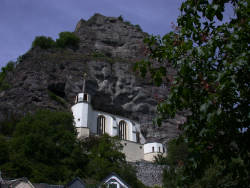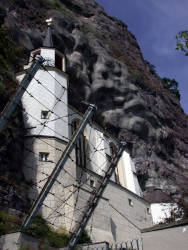Cave Churches
Cave Temple - Hypogeum


Cave churches are, as the name suggests, a combination of cave and church. This means a subterranean place of whatever kind, surrounded by rock and used as a place of worship for any religion. Cave churches or temples were built inside natural caves or by excavating temples out of solid rock.
Caves have always been a place of worship for god, deities or other spiritual rituals. Most prehistoric cave paintings are interpreted as having some kind of religious or shamanic background. But temples or churches in caves are more than some paintings. Some kind of altar, religious symbols and enough space for the participants of services are signs of a church. The Mithraic cult of ancient Rome used caves exclusively for its worship. Buddhist temples in Asia are often set up in natural caves.
Cave churches in natural caves
Natural caves have been used as churches or temples or places of worship for thousands, probably tens of thousands of years. The oldest are probably the image caves in France and Spain, if one wants to see a religious background for the creation of the images. All over the world, caves have been decorated with religious symbols and used as churches for different religions. Some very common types are:
- Mayan caves and cenotes which were considered the entrance to Xibalba.
- Caves dedicated to Archangel Michael, mainly in southern Italy, based on the cave of the dragon slain by Archangel Michael.
- a large number of Christian hermitages, which were later expanded into churches.
- Hindu cave churches in India with colourful images and stalagmites worshipped as lingam, the penis of Vishnu.
- Buddhist caves in the Far East, which are decorated with a multitude of Buddha statues.
Cave churches in artificial cavities
The other cave churches we talk about on this page are subterranea, which means artificial cavities, made by man. Often, when man had no natural caves for worship, he tried to build artificial caves replacing them. Sometimes it was an overhanging rock or a small cave which was widened until it fit the needs, sometimes it was a soft layer of rock which was used to dig out the cave for the church. Building a church of some size requires considerable architectural skills. Often it was much easier to simply hollow out a suitable rock. If one pays attention to creating a vaulted ceiling, the stability is usually great.
A very important reason for building cave churches or cave monasteries, as well as cave castles, is security. Many religions were persecuted, or simply the temples were robbed of the valuable cult objects. Thus, monasteries were often built on rocks (e.g. Meteora monasteries) or in steep rock faces. Usually, such a rock face offers little or no space, so most cave monasteries have dug out the space they need.
- Examples
 Barranco de Guayadeque, Spain.
Barranco de Guayadeque, Spain. Village troglodyte Rochemenier, France.
Village troglodyte Rochemenier, France. Loire Troglodytes, France.
Loire Troglodytes, France. St Ninian’s Cave, Britain.
St Ninian’s Cave, Britain. Agia Sophia, Greece.
Agia Sophia, Greece. San Giovanni d’Antro, Italy.
San Giovanni d’Antro, Italy. Peştera Ialomita, Romania.
Peştera Ialomita, Romania. Sveta Jama, Slovenija.
Sveta Jama, Slovenija. Grotto of St. Peter in Antioch, Turkey.
Grotto of St. Peter in Antioch, Turkey. Cave Dwellings of Cappadocia, Turkey.
Cave Dwellings of Cappadocia, Turkey. Pesterna Crkva Sveti Erazmo, Macedonia.
Pesterna Crkva Sveti Erazmo, Macedonia. Pesterna Crkva Sveti Stefan, Macedonia.
Pesterna Crkva Sveti Stefan, Macedonia. Pesterna Crkva Sveti Arhangel Mihail, Macedonia.
Pesterna Crkva Sveti Arhangel Mihail, Macedonia. Pesterna Crkva Sveta Bogorodica, Macedonia.
Pesterna Crkva Sveta Bogorodica, Macedonia. Pesterna Crkva Sveti Atanasie, Macedonia.
Pesterna Crkva Sveti Atanasie, Macedonia. Muqattam Mountain Cave Cathedral, Egypt.
Muqattam Mountain Cave Cathedral, Egypt.
 Search DuckDuckGo for "cave church"
Search DuckDuckGo for "cave church" Höhlenkultstätten (visited: 28-JUL-2011) an excellent overview on cave churches and temples, since prehistoric times and all over the world. By Franz Lindenmayr. (
Höhlenkultstätten (visited: 28-JUL-2011) an excellent overview on cave churches and temples, since prehistoric times and all over the world. By Franz Lindenmayr. ( )
) Index
Index Topics
Topics Hierarchical
Hierarchical Countries
Countries Maps
Maps